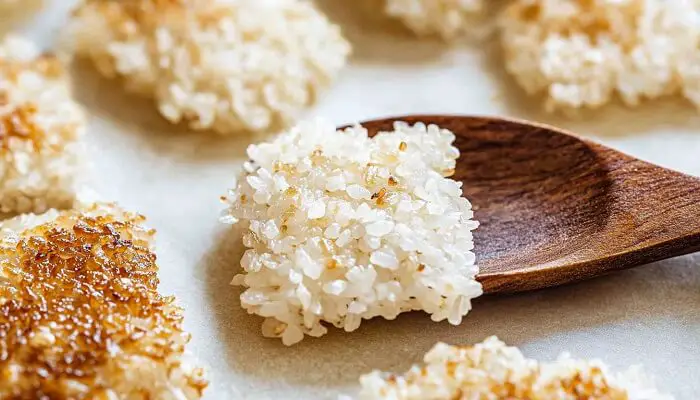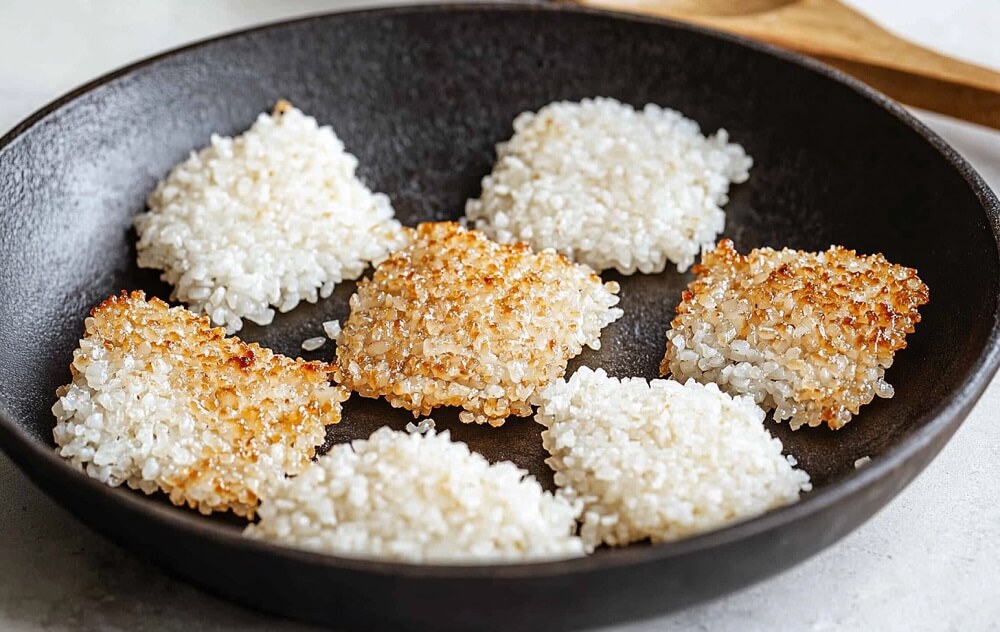Crispy rice has earned its place as a beloved culinary delight across cultures. Whether it’s the golden crust of Persian Tahdig or the delightful crunch of Korean Nurungji, crispy rice adds a unique texture and flavor to dishes that captivates food lovers.
The importance of crispy rice in culinary traditions cannot be overstated. It transforms humble rice into a versatile base or side dish with a satisfying crunch that complements both savory and sweet recipes. Achieving that golden, crunchy layer elevates even the simplest meals to gourmet status.
People often want to make their rice crunchy to enhance its texture, repurpose leftovers, or create unique recipes. This technique allows for endless creativity, from crispy rice patties to sushi bites with a crunchy twist.
In this guide, we’ll explore simple and effective methods to make crispy rice, from using leftover rice to mastering frying and baking techniques. Whether you’re an experienced cook or a beginner, you’ll learn how to achieve that perfect crispy texture while adding exciting flavors to your dishes.
What is Crispy Rice?
Crispy rice is a culinary preparation where rice is cooked or fried until it forms a golden, crunchy layer. This delightful texture contrasts beautifully with the softness of the inner rice, making it a favorite in various cuisines around the world.
Different cultures have their own unique takes on crispy rice. In Persian cuisine, Tahdig refers to the crisp, flavorful crust that forms at the bottom of the rice pot. In Korea, Nurungji is a popular snack and side dish made from scorched rice. Other variations include crispy rice crackers and fried rice balls found in Asian and Mediterranean cuisines.
Not all rice is equally suited for crispy rice dishes. Long-grain rice, such as basmati or jasmine, works well due to its lower starch content, which allows for better separation of grains. Short-grain rice, like sushi rice, is also excellent, offering a chewier, stickier texture that crisps up beautifully when fried or baked.
Common Challenges with Rice Texture
Achieving the perfect rice texture can be tricky, as small missteps can lead to mushy, undercooked, or overly sticky results. Understanding the reasons behind these issues is key to mastering rice preparation.
Why does rice become mushy or overly sticky?
- Excess water is a common culprit. When too much water is added, rice absorbs more than it needs, breaking down the grains and creating a sticky or gluey consistency.
- Stirring rice too often during cooking can also release starch, causing the grains to clump together.
- Overcooking rice is another issue, where prolonged exposure to heat and moisture ruins the ideal texture.
What causes undercooked rice?
- Insufficient water is the primary reason rice turns out undercooked or crunchy. Without enough steam, the grains fail to soften properly.
- Cooking rice at high heat for a shorter duration can also prevent proper hydration and even cooking.
How do mistakes lead to crunchy rice unintentionally?
- Uneven heat distribution can cause parts of the rice to remain undercooked. For instance, a pot with hot spots might cook one side while leaving the other side hard.
- Using incorrect ratios of rice to water, especially with certain rice types, can result in crunchy or unevenly cooked rice.
By identifying these common challenges and learning how to address them, you’ll be better equipped to prepare rice with the desired texture—whether soft and fluffy or perfectly crispy.
Ingredients and Tools Needed
To make crispy rice, you’ll need a few simple ingredients and basic kitchen tools. These ensure the process is smooth and the results are perfectly golden and crunchy.
Ingredients
- Rice: Leftover rice works best, but freshly cooked rice that has been cooled can also be used.
- Butter or Oil: Butter adds richness, while neutral oils like vegetable or sunflower oil are great for frying.
- Seasoning: Salt is essential, but you can also add spices like paprika, garlic powder, or herbs for extra flavor.
Tools
- Non-Stick Skillet: Ensures the rice doesn’t stick and allows for even cooking.
- Baking Sheet: Useful for oven-baking methods or cooling rice after cooking.
- Spatula: Ideal for pressing rice into an even layer and flipping it without breaking the crispy crust.
These ingredients and tools make it easy to create delicious, crispy rice with minimal fuss and maximum flavor.

Step-by-Step Guide to Make Crunchy Rice
4.1: Using Leftover Rice
Leftover rice is perfect for making crispy rice because it’s drier and less sticky, which helps achieve a crunchier texture. Here’s how to prepare and cook it:
- Preparing the Rice:
- Break up any clumps of rice with your hands or a fork to ensure even crispiness.
- If the rice feels too dry, sprinkle a small amount of water over it and toss lightly.
- Cooking in a Non-Stick Pan:
- Heat 2–3 tablespoons of butter or oil in a non-stick skillet over medium heat.
- Spread the rice in a thin, even layer across the skillet, pressing it down gently with a spatula.
- Cook for 5–8 minutes until the bottom turns golden brown. Avoid stirring or flipping prematurely to allow a crisp crust to form.
- Flip the rice carefully and cook the other side for an additional 3–5 minutes.
- Serve immediately or top with seasonings like soy sauce, sesame seeds, or fresh herbs.
4.2: Baking Rice for a Crispy Finish
Baking is a hands-off method that yields evenly crispy rice. Follow these steps:
- Layering the Rice:
- Preheat your oven to 375°F (190°C).
- Line a baking sheet with parchment paper or lightly grease it with oil.
- Spread the rice in a thin layer, ensuring there are no clumps.
- Baking Time and Temperature:
- Bake the rice for 15–20 minutes, flipping halfway through to ensure both sides become crispy.
- Keep an eye on the rice toward the end of baking to prevent burning.
This method works well for preparing large batches of crispy rice, perfect for entertaining or meal prepping.
4.3: Frying for Maximum Crunch
Frying creates the crispiest rice with a golden exterior and a satisfying crunch. This method is ideal for shaping rice into creative forms like patties or squares.
- Shaping the Rice:
- Take small portions of rice and form them into compact patties, squares, or even balls.
- If the rice isn’t sticking together, add a teaspoon of water or a light binding agent like egg or cornstarch.
- Shallow Frying:
- Heat about 1/4 inch of oil in a skillet over medium-high heat until it shimmers.
- Place the shaped rice into the skillet, ensuring there’s enough space between pieces.
- Fry each side for 2–3 minutes, or until golden brown and crispy.
- Remove from the skillet and place on a paper towel to drain excess oil.
This method results in irresistibly crunchy rice that can be used in appetizers, sushi dishes, or as a savory snack.
By mastering these methods, you can enjoy perfectly crispy rice tailored to your preferred cooking style and dish requirements.
How to Fix Rice That is Too Crunchy or Undercooked
Sometimes rice turns out too crunchy or undercooked due to insufficient water or uneven cooking. Fortunately, these issues are easy to fix with a few simple techniques. Here’s a step-by-step guide to salvage crunchy rice and ensure it’s soft and fully cooked.
Assess the Situation
- Check if the rice is crunchy because it lacks water or if it’s simply undercooked.
- If it’s dry and hard, it likely needs more water. If the grains are partially cooked but still firm, a little more steaming may solve the issue.
Add Moisture
- For Slightly Crunchy Rice:
- Add 1/4 cup of water for every cup of rice in the pot.
- Stir the rice gently to distribute the water evenly.
- For Very Dry or Hard Rice:
- Add 1/2 cup of water and stir gently.
- Optionally, place a damp paper towel over the rice to help trap steam.
Reheat the Rice
- Cover the pot with a tight-fitting lid to trap the steam.
- Turn the heat to low and let the rice simmer gently for 5–10 minutes.
- Avoid stirring during this process to allow the grains to absorb the added moisture evenly.
Fluff and Check
- Once the water is absorbed, fluff the rice with a fork to check its texture.
- If it’s still not fully cooked, repeat the process with smaller increments of water.
Alternative Methods
- Microwave Fix: Place the rice in a microwave-safe bowl, add water, cover with a damp paper towel, and heat for 1–2 minutes.
- Steaming: Transfer rice to a steamer basket, add water to the base, and steam for 5–7 minutes.
With these techniques, even overly crunchy or undercooked rice can be transformed into soft, fluffy grains ready to enjoy!
Enhancing Flavors of Crispy Rice
Crispy rice is delicious on its own, but incorporating spices, herbs, and creative toppings can take it to the next level. By adding bold flavors and textures, you can transform crispy rice into a unique and versatile dish.
Incorporating Spices and Herbs
- Infuse the rice with flavor by mixing in spices before frying or baking. Popular choices include:
- Paprika or smoked paprika for a rich, smoky taste.
- Cumin for an earthy, warm flavor.
- Chili powder or flakes for a spicy kick.
- Fresh herbs like cilantro, parsley, or mint can be sprinkled on top after cooking to add a fresh, aromatic finish.
- Garlic or onion powder is excellent for adding depth without overwhelming the dish.
Fusion Ideas with Toppings
- Asian-inspired flavors: Drizzle crispy rice with soy sauce or tamari for umami richness. Top with sesame seeds and a dash of sriracha for heat and crunch.
- Mediterranean twist: Add a dollop of tzatziki, sprinkle with za’atar, or top with crumbled feta and olives.
- Sweet and savory mix: Use honey, crushed nuts, or even a hint of cinnamon for a playful fusion.
Experimenting with these combinations allows you to tailor crispy rice to suit any cuisine or occasion, making it a flavorful centerpiece for any meal!
FAQs Section
1. Why is my rice not crispy enough?
Crispy rice requires proper preparation and cooking techniques. Common mistakes that prevent crispiness include:
- Using fresh rice: Freshly cooked rice is too moist; use leftover or cooled rice for better results.
- Insufficient oil or butter: A thin layer of oil or butter is essential to create the golden crust.
- Not spreading the rice evenly: Uneven layers lead to inconsistent cooking, with some parts crispy and others soft.
- Cooking on low heat: Medium to high heat ensures the rice crisps properly without overcooking.
2. Can I use any type of rice?
Not all rice varieties are equally suited for making crispy rice. Here’s a quick guide:
- Long-grain rice (e.g., jasmine, basmati): Produces crispy rice with separate grains due to its lower starch content.
- Short-grain rice (e.g., sushi rice): Forms a chewier, stickier crust and is great for shaping into patties or squares.
- Both types work well, but the choice depends on your desired texture.
3. How do I store crispy rice?
To preserve crispy rice:
- Allow it to cool completely before storing.
- Place it in an airtight container to prevent moisture absorption.
- Store at room temperature for up to 1 day or refrigerate for up to 3 days. Reheat in a skillet or oven to restore crispiness.
4. What dishes pair well with crispy rice?
Crispy rice complements many recipes, such as:
- Asian-inspired dishes: Pair with stir-fried vegetables, teriyaki chicken, or sushi rolls.
- Mediterranean cuisine: Serve with hummus, grilled meats, or roasted vegetables.
- Snack ideas: Use crispy rice as a base for avocado toast or top with smoked salmon and cream cheese.
Popular Recipes for Crispy Rice
Crispy rice has been adapted into a variety of beloved dishes across different cuisines. Here are three popular recipes that showcase the versatility and deliciousness of crispy rice.
Persian Tahdig
Tahdig is a traditional Persian dish known for its golden, crispy crust at the bottom of the rice pot. To make Tahdig:
- Rinse and parboil long-grain rice like basmati.
- Mix oil, butter, and a pinch of saffron with water and spread it at the bottom of a non-stick pot.
- Layer the parboiled rice on top, pack it down gently, and cover the pot.
- Cook on low heat for about 30–40 minutes until the bottom forms a crispy, golden crust. Serve Tahdig with stews or kabobs for an authentic Persian experience.
Korean Nurungji
Nurungji is a scorched rice dish commonly enjoyed as a snack or paired with soups. Here’s how to make it:
- Spread cooked short-grain rice in a thin layer in a non-stick skillet.
- Cook over medium heat until the bottom becomes crispy and lightly browned.
- Flip and cook the other side, or break it into pieces and serve as is. For added flavor, sprinkle with sesame seeds or drizzle with soy sauce.
Crispy Rice Sushi Appetizers
These trendy appetizers combine crispy rice with sushi toppings:
- Form cooled sushi rice into small rectangles or squares.
- Pan-fry the rice shapes in oil until golden and crispy.
- Top with spicy tuna, avocado, or sashimi, and garnish with soy sauce or sriracha. Perfect for parties, these appetizers are a crowd-pleaser with a crunchy twist!
These recipes highlight how crispy rice can elevate any meal, from traditional dishes to modern creations.
Conclusion
Crispy rice is a versatile and flavorful dish that adds a delightful crunch to any meal. From frying leftover rice in a skillet to baking it in the oven or shaping it into creative appetizers, the methods to achieve crispy rice are both simple and rewarding. Key techniques include starting with cooled or leftover rice, using the right amount of oil or butter, and cooking at the right heat for a golden, crunchy texture. Each method offers unique results, whether it’s the rich crust of Persian Tahdig, the snackable layers of Korean Nurungji, or the trendy appeal of crispy rice sushi bites.
The beauty of crispy rice lies in its adaptability. By experimenting with spices, herbs, and toppings, you can personalize recipes to suit your taste or complement different cuisines. Whether you prefer smoky paprika, a drizzle of soy sauce, or fresh cilantro, there’s no limit to the flavors you can explore.
Crispy rice isn’t just a technique—it’s a canvas for culinary creativity. So, gather your ingredients, try out the methods, and don’t be afraid to make it your own. With practice and imagination, you’ll master the art of crispy rice and delight your taste buds with every crunchy bite!






